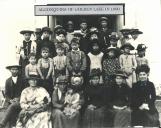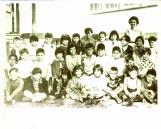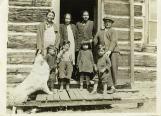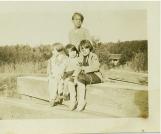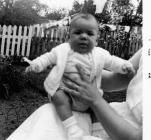27
At Indian Day School you could go up to senior 4th or grade eight.In those times we came to school in bare feet if we didn’t have shoes, and in the winter, once it was cold enough, we could wear moccasins because they wouldn’t get wet. In the winter it was hard for some of us to get to school. Sometimes the snow was so high that you couldn’t even see the boxcars when the train went through. Some children had to walk up to three or four miles.
Some of us came on sleds that our dogs pulled.
29
The third school, located where the post boxes are now, was still one room for all grades. There was a teacher’s residence built over top.Someone would come in early and fire-up the wood stove and lunch was cooked there. We were also fed wood-like, government-issue vitamin biscuits and cod liver oil. If there was a good teacher, we would have events like skating parties; if not, things were rougher.
After Day School we could go away to boarding school, but Indian Affairs didn’t pay for it, and many of us were to poor to go.
We could also attend high school in Eganville by train, but you didn’t get back till 8 at night. After
school we’d have chores like filling the water barrel and wood box.
31
Some of our children were sent away to the Catholic residential school at Spanish and weresubjected to the physical and sexual abuse and isolation that residential school is now known
for. In this school system, they cut off our hair, separated the boys from the girls, punished us
for speaking our language, and for waving at brothers or sisters from our own families. We
were dressed in the way they believed white children should dress, and the girls were trained
to be kitchen help and boys to be farm hands. We were always hungry there, and some of us
took apples from the root cellar to eat because we were never given any.
We were cut off from our families, their caring, and the experience and stories that could teach us our traditions and history. Some of us stayed a long time, came back, and are sad remembering those times.
Often our children have suffered for our experience there. We were told by the Mounties, the
Indian agent, and children’s services, who came to take our children, that “it was for their own
good.” Many of our children died there.
33
The implementation of government regulation and policy continued to be prejudiced,inhumane, and disheartening when family relationships suffered again as we lost our children
to what has come to be known as the “60’s Scoop”. Many of our children were taken by Indian
Affairs and Children’s Aid, through pressure put on young mothers in childbirth, or by taking
them, often without our consent, right from our homes, while we were struggling to try to
make ends meet.
34
Mary Bernard and Ruby Houston swimming in Golden Lake1900-1930
Pikwŕkanagŕn, ON
 Credits:
Credits:Jill Closter
35
Seventy percent of our children who were taken during this time were placedin non-Indian families. The agencies responsible considered us to be inferior because of our
poverty, even though it was imposed upon us by unjust legislation and circumstances. As a
result, we were alienated from our children and them from us. But the removal of our children
was slowed – and made to involve lengthy and costly court proceedings – when our band
administrator, on behalf of Chief and council, wrote to the Children’s Aid Society requesting
that they follow their own rules and institute the Child Welfare Act only. Over the years, some
of our children who were adopted out found out where they were from and returned, but
many have not. Some of our relatives, who are strangers to us, still enter our lives from time to
time.
37
A daycare was started in 1979 on the reserve, and today our children’s school readinessprogramming is integrated with Algonquin, English and cultural teachings.
39
Older children attend schools in the surrounding communities, since ‘integration’ was instituted in the sixties.There is an Algonquin language program at both elementary schools in Eganville, and a Native
Studies program at the district high school.
We also have a post-secondary education counsellor who helps our college and university students adjust to life on campus and achieve their goals.
40
Still Hunting with Pikwŕkanŕgan Day Camp21 July 2011
Footprints in Time Trail, Bonnechere Provincial Park, Ontario, Canada
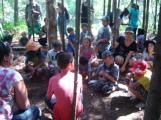 Credits:
Credits:Bonnechere Provincial Park,ON
Pikwakanagan Day Camp
